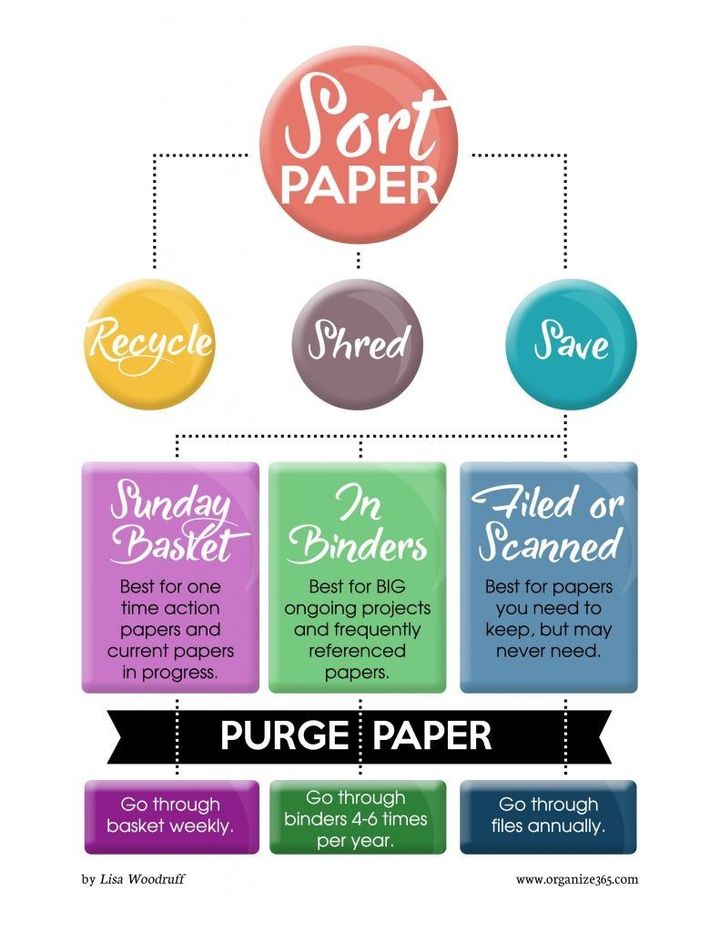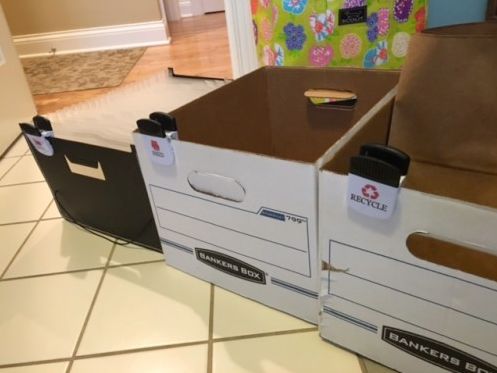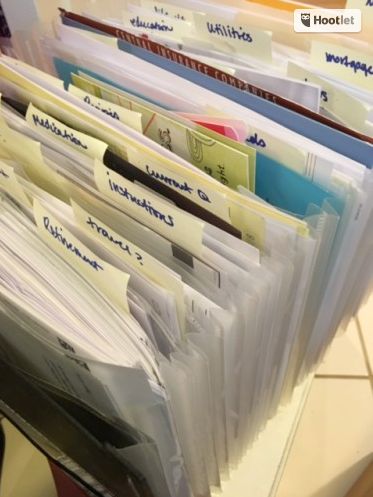
I LOVE to sort paper! But I know even the strongest man will break out into a cold sweat at the thought of sorting a mountain of paperwork.
The amount of paper we can accumulate in our household is crazy.
Bills, coupons and junk mail arrive in our mail boxes every day. Our kids bring home report cards, art projects, teacher notices and party invitations. We print out recipes and to-do lists. All of this paper piles up at an alarming rate.
How do you decide what to do with it?
To help you sort through all of this paper I have created an easy to follow 3 step process (with a handy flow chart!), that I use for both myself and my clients. Following this process will help you decide what to get rid of and how to organize what you need to keep.

Organize 365
Which papers get to stay or which papers need to go?
When helping my clients go through this process I always start by asking them 10 basic questions. The questions include - do you want to save coupons? What types of coupons would you like to save? Do you want to keep old utility bills or just the previous months? Questions like these help me to quickly determine what needs to stay and what needs to go, without analyzing each and every paper I come across.
Once you’ve answered these questions, it’s time to sort your paper. Start by creating three bins, or at least three designated locations and label them recycle, shred and save. Each piece paper that you go through is going to be placed into one of these bins.

When I am working with clients, we’d use my paper filing clips to label which box is which
So which papers get to go into which bin?
Recycling Bin
The recycling bin is a place for any papers you don’t want to keep which don’t contain any important personal information. Expired coupons, junk mail and past school flyers are just some examples of papers which can find their way into the recycling bin.
Shred (Trash) Bin
The shred (or trash) bin is also a place for unwanted papers, but these are items which contain personal information. Bank statements, medical forms and tax forms all go into this bin.
It’s important that this information is shredded to help protect your identity and the privacy of you and your loved ones.
Save Bin
The save bin is for any important items you feel need to be kept. This can include bills that still need to be paid or a kid’s art project that you particularly love. Whatever the reason is, the piece of paper is important to you and needs to be kept, at least for the time being.
This is the task that people struggle with the most.
My flow chart helps you out here.
There are 3 destinations for your saved paper – Sunday Basket, Binder, or File/Scan.
How do you decide what goes where? There are three basic rules.
1: Do you need to take action?
If the answer is “yes” then the paper goes into your Sunday Basket™.
The Sunday Basket™ is a basket you go through once a week and it contains items that need some sort of action taken.
Going through the Sunday Basket™ helps you to plan out your week and keep track of everything that needs to be done. This is the perfect place for any paper items that require action.
An example of where action needs to be taken could be a party invitation that requires an RSVP, a card and gift…etc. Or a bill that needs to be paid.
To find out more about the Sunday Basket™ click here and search Sunday Basket™ on my website for lots of information about it.

2. Is the paper related to a larger project and will you need it as a reference or to take it to a meeting?
If your answer is “yes” then it goes into a binder.
Binders are the best place to keep paper items which you may need to refer to quickly or frequently.
Any long term project you are working on, a school carnival for example, should have its own binder. Binders make it easy to keep all the information you need in one place and it is easy to transport when you need to bring it to a meeting with you.

3. Are you saving the paper because “you might need it someday” but it is not a CURRENT project or task
If the answer is “yes” then it gets filed or scanned.
Files are a great place to keep papers that don’t need to be referenced often. Tax forms, which are only glanced at once a year, are a definite for the file folder.
Another option is to scan these items into the computer and file them electronically.

Here are pictures of how I sort papers at a client’s house
Of course once you have your papers organized you want to keep them that way. We move onto Step 3…
It’s important for you to conduct regular maintenance on all paper organizing systems to keep you from accumulating excess paper.
Your Sunday Basket needs to be checked (you guessed it) every Sunday. It also doesn’t have to be on Sunday, just as long as it’s weekly on whichever day works best for you.
Any binders you create should be flipped through every 4-6 months. Personally, I always feel the need to sort through them with the change of the seasons.
Lastly, any files or scans that you have should be purged annually to keep them relevant.
By following this flow chart and getting your papers organized you will save yourself both time and stress. All of the papers you need will be readily available and you’ll be able to locate them in minutes.
Good luck with your organizing. Now go sort your paper!
This post originally appeared on podcast #90 of the Organize 365 Podcast
